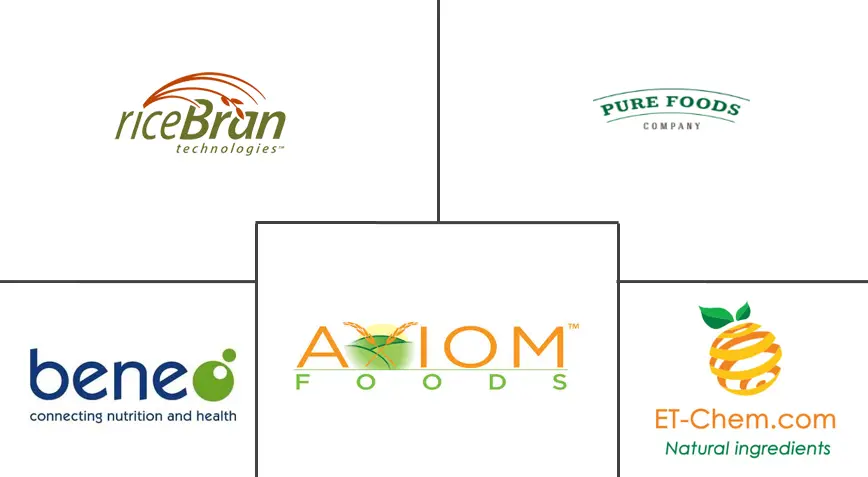Market Size of South America Rice Protein Industry

| Study Period | 2019 - 2029 |
| Base Year For Estimation | 2023 |
| Forecast Data Period | 2024 - 2029 |
| Historical Data Period | 2019 - 2022 |
| CAGR | 4.20 % |
| Market Concentration | Medium |
Major Players
*Disclaimer: Major Players sorted in no particular order |
South America Rice Protein Market Analysis
The South American rice protein market is expected to register a CAGR of 4.2%, during the forecast period, 2020 to 2025.
- Consumers have been observed to avoid animal protein-based products to refrain from residues of antibiotics and hormones found in meat, which has led them to opt for alternative protein sources like rice protein. For the food industry, rice proteins are usually isolated from sources such as regular rice flours or rice bran.
- Rice protein has gained popularity in South America and is being utilized in combination with pea protein, which formulates a complete protein profile with health benefits including tissue rebuilding and recovery of muscles. The market is further fueled by increasing awareness among consumers about the dietary supplements products with rice protein being used as one of the major ingredients.
South America Rice Protein Industry Segmentation
The South America rice protein market is segmented by product type, application, and geography. Based on product type, the market is segmented into rice protein isolate, rice protein concentrate, & others. Based on application the market is segmented into food ingredients which are further sub-segmented into energy & sports drink, meat analogs, beverages, & bakery & confectionery, with dietary supplements and animal feed. Based on Geography, the study provides an analysis of the rice protein market in Brazil, Argentina, Colombia, and Rest of South America.
| By Product Type | |
| Rice Protein Isolate | |
| Rice Protein Concentrate | |
| Others |
| By Application | ||||||
| ||||||
| Dietary Supplements | ||||||
| Animal Feed |
| By Geography | |
| Brazil | |
| Argentina | |
| Colombia | |
| Rest of South America |
South America Rice Protein Market Size Summary
The South American rice protein market is experiencing a notable shift as consumers increasingly seek alternatives to animal-based proteins due to concerns over antibiotics and hormones in meat. This trend has led to a growing preference for rice protein, which is often combined with pea protein to create a complete protein profile beneficial for muscle recovery and tissue rebuilding. The market's expansion is driven by heightened consumer awareness of dietary supplements that incorporate rice protein as a key ingredient. In Brazil, the plant-based protein sector is rapidly evolving, with numerous product launches across various retail channels, including natural food stores and supermarkets. Despite being relatively new, the Brazilian market shows a significant number of individuals identifying as vegan or vegetarian, comparable to more established markets. This shift is supported by marketing strategies that emphasize the health benefits of plant-based diets over animal products, resonating well with health-conscious consumers.
The convenience of purchasing plant-based proteins from established retail chains has also contributed to increased sales in this segment. Rice protein isolates, derived from the by-products of rice processing, offer a high-protein, allergen-free option that is particularly appealing for those engaging in resistance training, as it supports muscle hypertrophy and improves body composition. Key players in the South American rice protein market, such as RiceBran Technologies, Axiom Foods, and Beneo, are actively adapting their product portfolios to meet evolving consumer demands. While the market is still in its early stages in Brazil, the growth of plant protein alternatives provides a robust foundation for rice protein. However, competition in product incorporation across various application segments presents challenges that could impact market dynamics.
South America Rice Protein Market Size - Table of Contents
-
1. MARKET DYNAMICS
-
1.1 Market Drivers
-
1.2 Market Restraints
-
1.3 Porter's Five Forces Analysis
-
1.3.1 Threat of New Entrants
-
1.3.2 Bargaining Power of Buyers/Consumers
-
1.3.3 Bargaining Power of Suppliers
-
1.3.4 Threat of Substitute Products
-
1.3.5 Intensity of Competitive Rivalry
-
-
-
2. MARKET SEGMENTATION
-
2.1 By Product Type
-
2.1.1 Rice Protein Isolate
-
2.1.2 Rice Protein Concentrate
-
2.1.3 Others
-
-
2.2 By Application
-
2.2.1 Food Ingredients
-
2.2.1.1 Energy & Sports Drinks
-
2.2.1.2 Meat Analogues
-
2.2.1.3 Beverages
-
2.2.1.4 Bakery & Confectionery
-
-
2.2.2 Dietary Supplements
-
2.2.3 Animal Feed
-
-
2.3 By Geography
-
2.3.1 Brazil
-
2.3.2 Argentina
-
2.3.3 Colombia
-
2.3.4 Rest of South America
-
-
South America Rice Protein Market Size FAQs
What is the current South America Rice Protein Market size?
The South America Rice Protein Market is projected to register a CAGR of 4.20% during the forecast period (2024-2029)
Who are the key players in South America Rice Protein Market?
Axiom Foods, Rice Bran Technologies, Pure Food Company, Nutribiotic and BENEO GmbH are the major companies operating in the South America Rice Protein Market.

